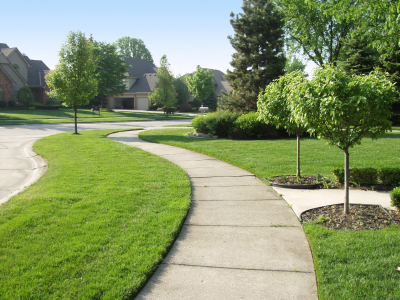The summer season brings about glorious days of warm weather and outdoor activities that keep us outside of hours upon hours at a time. For some, most of those hours during these months are used to maintaining a healthy landscape around their homes.
While some homeowners know exactly what their lawn needs on a daily basis, most will find that they have issues keeping their grass healthy and, in turn, will be looking at a very barren dry lawn by the time fall rolls around.
Below are some tips and procedures that can assist any homeowner in making their lawn healthy throughout the hot summer seasons.

Mowing the Lawn
A healthy lawn does not necessarily mean that it has to be short. When cutting into your lawn, the blades need to be set as high as possible. The length of grass, preferably high, provides numerous amounts of benefits towards keeping the soil healthy and productive.
Tall blades of grass are able to obtain more light during peak sun hours and, in turn, will use this energy to produce and provide more nutrients to the roots and surrounding soil. Taller blades will also provide shade that allows for the soil surrounding each blade of grass to maintain moisture throughout the dry heat of most summer days.
Need Help With Your Lawn?
Grass Clippings
The waste produced in regards to your mowing should not be considered waste. The clippings that you produce during your mowing time should be redistributed across the lawn.
There are certain mowers that do not collect clippings in bags but rather just cut and allow for the shredded lawn to fall back into the grass and the soil. These cut blades of grass will be able to supply the soil with an added supply of nutrients as well as additional shade to further along the growth of a healthy lawn.
Fertilization
Fertilization at both the beginning of the spring season as well as at the end of the fall season is vital to your grass maintaining a healthy lifestyle.
Most organic fertilizers used in the spring allow for the soil to be kick started with an abundance of nutrients to inhibit growth at a more rapid pace. On the opposite side of the spectrum, most winterizing fertilizers allow for the soil to capture nutrients and store there to maintain a healthy landscape during the harsh snow and inclement weather of the winter.
Seeding
Any patches of lawn that do not seem to grow properly needs to be seeded accordingly. Patience is the key in this situation because some homeowners tend to seed barren lawn patches more than once which in turn will cause the soil to be overworked.
Seeding once and maintaining a proper water schedule on those parts will show some improvements in the days and weeks to come.
Weeding
Weeds are a nuisance to any lawn across the country. There has to be a conscious effort to walk your lawn on an every other day basis to find any instance of weeds and remove as soon as possible. This will allow you to catch newly formed weeds before they have a chance to grow roots and stake a claim in the soil of your lawn.
Watering
Hydration is essential to the growth and nutrition of your lawn. The entire landscape surrounding your home needs to have at least an inch of water on a weekly basis. This inch of water can come from rain or can come from manual irrigation through your water hose.
The main keys to remember when it comes to manual hydration are to water as early as possible as well as not to over-saturate your lawn.
All watering must be done in the early morning hours so that the soil can absorb all moisture before any sun and or heat has a chance to dry it up. The watering must be measured, through the use of a coffee can as an example, to make sure that you do not over water the lawn and cause the soil to become infertile due to too much moisture.
Clean Slate
The landscape of your home should remain clean at all times and seasons, especially in the fall. Leaves and debris will find its way to the ground from surrounding trees and will cause havoc to the soil if not cleaned. If there is no clean-up, the leaves will remain on the ground through the winter months and, in turn, cause an unsafe setup of nutrients and bugs to inhabit the soil and delay growth in the spring months.

2 Comments
Thanks for the information I found it useful and reinforced what I already knew.
How do you get rid of clover that is growing on your lawn?